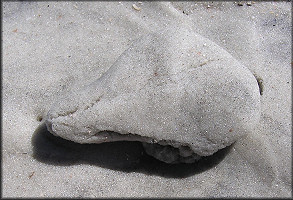|
Stuff Happens |
|
|
By Bill Frank |
|
|
Most shell collectors are keenly aware of the fact that a vast majority of the tens of thousands of marine and non-marine gastropod species are normally dextral (right handed - i. e., the shell opening is to the right when held spire upwards) while only a limited number of taxa such as Busycon perversum, the few species of the fasciolariid subgenus Sinistralia, and most of the speciose family Triphoridae, among others, are normally sinistral (left handed - the shell opening is to the left when held spire upwards). However, accidents of nature do happen, and occasionally a sinistral specimen of a normally dextral species or a dextral specimen of a normally sinistral species will be found. However, a reverse-coiled gastropod is still sufficiently rare that virtually all shell collectors never “knowingly” find a specimen during their lifetimes. But there are exceptions. I recently was fortunate enough to have collected not one, but two reverse coiled gastropods (one terrestrial and one marine species) in a three week period here close to home in Duval County.
|
|
| Subsequently, during a marine collecting trip to Little Talbot Island during a low tide on March 6th, a small (71 mm.) dextral Busycon perversum (Linnaeus, 1758) (Lightning Whelk – a species which is normally sinistral) was found on an off-shore sand bar. When excavated from the sand, it was initially believed to be a small Busycon carica (Gmelin, 1791) [Knobbed Whelk] since both species are found in the area and are very similar in appearance other than the fact that Busycon perversum is normally sinistral and Busycon carica is normally dextral. But the dextral specimen just didn’t look exactly right and closer examination revealed it had characteristics of Busycon perversum not to mention the black colored animal normal for that species. The animal of Busycon carica is light cream in coloration. By the time that the identification was resolved to my satisfaction and photographs taken, the tide had had begun flooding back in, and it was a very cold wade through waist-deep water to return safely to shore. The identification was further confirmed after cleaning and by examination of the protoconchs of the two species involved under a microscope. | |
|
|
|
|
Dextral Busycon perversum in situ waiting to be discovered |
Dextral Busycon perversum on the left |
|
The two collecting events described above, which produced two reverse coiled gastropods, could have just as easily been just another day in the field if not for attention to detail and plain old luck. It’s easy to envision that both of the rare shells would have been overlooked by one with less experience or one not specifically looking for reverse coiled specimens. It does make one wonder if maybe reverse coiled gastropods aren’t really that rare but instead just not recognized as such by collectors; especially in regards to some of the smaller species which might need to be examined under a microscope to determine their orientation. Also see: Guide To Northeast Florida Whelks |
|
![Sinistral Ventridens cerinoideus (Anthony, 1865) [Wax Dome]](derm1.jpg)

